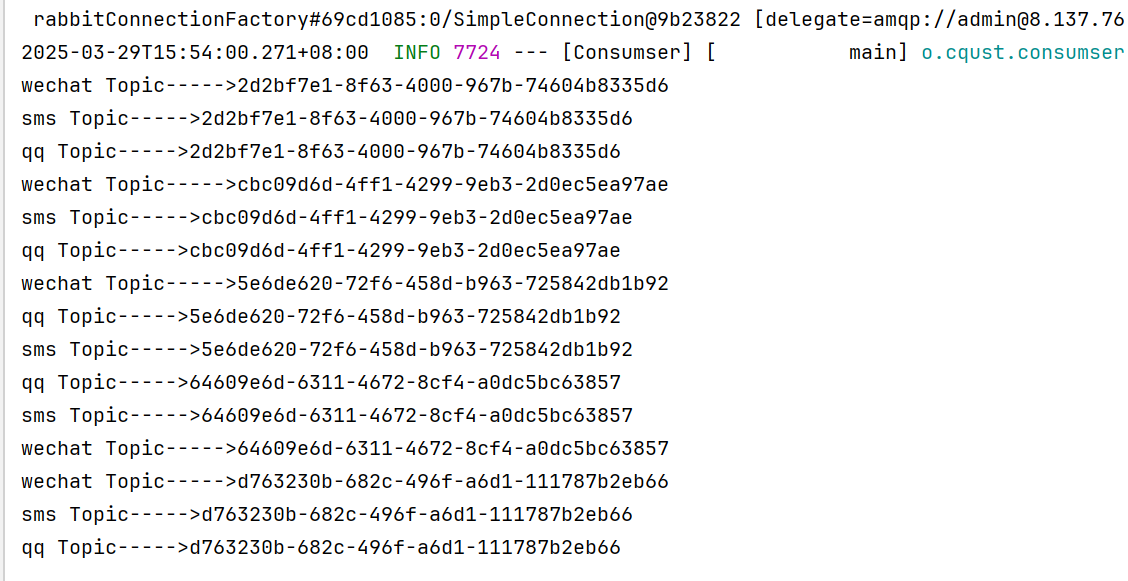SpringBoot整合RabbitMQ--Direct和Topic模式
一.Direct模式
这几个模式使用SpringBoot的整合和前面使用源生Java整合其实是差不多的,故而步骤就不再详细赘述了,直接先导入依赖:
<dependency> <groupId>org.springframework.boot</groupId> <artifactId>spring-boot-starter-amqp</artifactId> </dependency> <dependency> <groupId>org.springframework.boot</groupId> <artifactId>spring-boot-starter-web</artifactId> </dependency> <dependency> <groupId>org.springframework.amqp</groupId> <artifactId>spring-rabbit-test</artifactId> <scope>test</scope> </dependency>

配置连接信息:
server:
port: 9002
spring:
rabbitmq:
username: admin
password: admin
virtual-host: /
host: 8.137.76.12
port: 5672
direct业务类,负责发送有关routingkey = ‘qq’ 和 ‘sms’的队列
import org.springframework.amqp.rabbit.core.RabbitTemplate; import org.springframework.beans.factory.annotation.Autowired; import org.springframework.stereotype.Service; import java.util.UUID; @Service public class DirectService { //注入rabbitMQ模板 @Autowired private RabbitTemplate rabbitTemplate; //定义交换机的名字 private String exchangeName = "direct_order_exchange"; //定义路由key private String routingKey = "qq"; //制造订单 public void makeOrder(Long userID,Long productID,int num){ String uuid = UUID.randomUUID().toString(); System.out.println("用户:"+userID+",订单是:"+uuid); rabbitTemplate.convertAndSend(exchangeName,routingKey,uuid); rabbitTemplate.convertAndSend(exchangeName,"sms",uuid); } }
注册交换机(拼接到springBoot整合fanout模式的配置类中的):
@Bean public DirectExchange directExchange(){ return new DirectExchange("direct_order_exchange",true,false); } //绑定关系,将交换机和队列进行绑定 @Bean public Binding bindQue1(){ return BindingBuilder.bind(qqQueue()).to(directExchange()).with("qq"); } @Bean public Binding bindQue2(){ return BindingBuilder.bind(WeChatQueue()).to(directExchange()).with("wechat"); } @Bean public Binding bindQue3(){ return BindingBuilder.bind(smsQueue()).to(directExchange()).with("sms"); }
生产者测试方法:
@Autowired DirectService directService; @Test void dirctTest() throws InterruptedException { for (int i = 0; i < 5; i++) { Thread.sleep(1000); Long userId = 100L+ i; Long produceId = 10001L + i; int num = 10; directService.makeOrder(userId,produceId,num); } }
消费者和SpringBoot整合fanout模式一样,没有修改
启动测试:
生产者:

消费者:

二.Topic模式
使用模糊匹配模式的代码都是差不多的,但是在绑定交换机上我们使用注解来绑定,而不是再使用配置类来绑定了
生产者:
@Service public class TopicService { //注入rabbitMQ模板 @Autowired private RabbitTemplate rabbitTemplate; //定义交换机的名字 private String exchangeName = "topic_order_exchange"; //定义路由key //"#.qq" //"#.sms.#" //"*.wechat.#" private String routingKey = "sms.wechat.qq"; //制造订单 public void makeOrder(Long userID,Long productID,int num){ String uuid = UUID.randomUUID().toString(); System.out.println("用户:"+userID+",订单是:"+uuid); rabbitTemplate.convertAndSend(exchangeName,routingKey,uuid); } }
声明一个交换机,和其队列,不需要再配配置类绑定,使用注解再消费者上直接绑定:
//注册rabbitMQ队列 @Bean public Queue qqQueue(){ //队列的名称 // durable:是否持久化,默认是false,持久化队列:会被存储在磁盘上,当消息代理重启时仍然存在,暂存队列:当前连接有效 // exclusive:默认也是false,只能被当前创建的连接使用,而且当连接关闭后队列即被删除。此参考优先级高于durable // autoDelete:是否自动删除,当没有生产者或者消费者使用此队列,该队列会自动删除。 // return new Queue("TestDirectQueue",true,true,false); //一般设置一下队列的持久化就好,其余两个就是默认false return new Queue("qqQueue",true); } @Bean public Queue WeChatQueue(){ //一般设置一下队列的持久化就好,其余两个就是默认false return new Queue("WeChatQueue",true); } @Bean public Queue smsQueue(){ //一般设置一下队列的持久化就好,其余两个就是默认false return new Queue("smsQueue",true); } //声明交换机
@Bean public TopicExchange topicExchange(){ return new TopicExchange("topic_order_exchange",true,false); }
测试方法:
@Autowired TopicService topicService; @Test void topicTest() throws InterruptedException { for (int i = 0; i < 5; i++) { Thread.sleep(1000); Long userId = 100L+ i; Long produceId = 10001L + i; int num = 10; topicService.makeOrder(userId,produceId,num); } }
消费者,需要绑定交换机和当前队列的关系,以及指定路由Key
qq消费者:
import org.springframework.amqp.core.ExchangeTypes; import org.springframework.amqp.rabbit.annotation.*; import org.springframework.stereotype.Component; @Component // bindings其实就是用来确定队列和交换机绑定关系 @RabbitListener(bindings =@QueueBinding( // qqQueue 是队列名字,这个名字你可以自定随便定义。 value = @Queue(value = "qqQueue",autoDelete = "false"), // topic_order_exchange 交换机的名字 必须和生产者保持一致 exchange = @Exchange(value = "topic_order_exchange", type = ExchangeTypes.TOPIC), key = "#.qq" )) public class QQConsumer { @RabbitHandler public void qqMsg(String message){ System.out.println("qq Direct----->"+message); // 打印接收到的消息 } }
wechat消费者:
import org.springframework.amqp.core.ExchangeTypes; import org.springframework.amqp.rabbit.annotation.*; import org.springframework.stereotype.Component; @Component // bindings其实就是用来确定队列和交换机绑定关系 @RabbitListener(bindings =@QueueBinding( // WeChatQueue 是队列名字,这个名字你可以自定随便定义。 value = @Queue(value = "WeChatQueue",autoDelete = "false"), // topic_order_exchange 交换机的名字 必须和生产者保持一致 exchange = @Exchange(value = "topic_order_exchange", type = ExchangeTypes.TOPIC), // 这里是确定的rabbitmq模式是:TOPIC 是以广播模式 、 发布订阅模式 key = "*.wechat.#" )) public class WechatConsumer { @RabbitHandler public void qqMsg(String message){ System.out.println("wechat Direct----->"+message); // 打印接收到的消息 } }
sms消费者:
import org.springframework.amqp.core.ExchangeTypes; import org.springframework.amqp.rabbit.annotation.*; import org.springframework.stereotype.Component; @Component // bindings其实就是用来确定队列和交换机绑定关系 @RabbitListener(bindings =@QueueBinding( // smsQueue 是队列名字,这个名字你可以自定随便定义。 value = @Queue(value = "smsQueue",autoDelete = "false"), // topic_order_exchange 交换机的名字 必须和生产者保持一致 exchange = @Exchange(value = "topic_order_exchange", type = ExchangeTypes.TOPIC), key = "#.sms.#" )) public class smsConsumer { @RabbitHandler public void qqMsg(String message){ System.out.println("sms Direct----->"+message); // 打印接收到的消息 } }
如上代码就是使用注解绑定交换机和队列的关系:
结果截图,生产者生产消息:

消费者消费消息:

如上使用Topic的模糊匹配将所有的路由key都匹配上了,故而所有队列都受到了。
------END------


 浙公网安备 33010602011771号
浙公网安备 33010602011771号